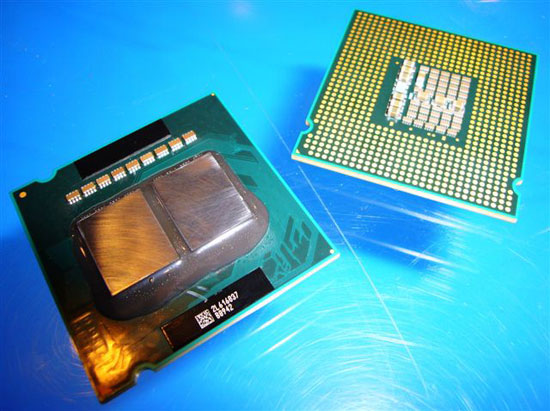Intel Core 2 Extreme QX6850 and Massive Price Cuts
by Anand Lal Shimpi on July 16, 2007 3:04 AM EST- Posted in
- CPUs
Do Four Cores Need a 1333MHz FSB?
AMD likes to call Intel's quad-core "fake" due to the fact that the chips themselves are composed of two independent dual-core die on a single package. Intel has used this multi-die package approach ever since the dual-core days in order to get CPUs to market quicker and do so at a lower cost. While Intel will eventually move to a single die quad-core design, its current designs are made up of two individual dual-core die.

The problem with Intel's approach is that all traffic from one pair of cores to the next has to go over the FSB, whereas AMD's quad-core Barcelona design places all four cores behind a shared L3 cache. With a single socket quad-core chip, FSB bandwidth is already at a premium given that four cores have to share the same amount of FSB bandwidth that two cores do in a dual-core system. In theory, Intel's quad-core CPUs could stand to benefit more from a 1333MHz FSB than their dual-core counterparts. You may remember from our review of the Core 2 Duo E6750 that the 1333MHz FSB only accounted for an average performance improvement of 1.9% over the 1066MHz FSB, but would things change with four cores running on the other end of that FSB?
To find out we compared the Core 2 Extreme QX6850 to the Core 2 Extreme QX6800, the former running at 3.0GHz on a 1333MHz FSB and the latter 2.93GHz/1066MHz. There is a 2.3% increase in clock speed that the QX6850 enjoys over the QX6800, but we can easily take that into account when looking at the margin of victory in our tests.
The chart below shows the performance increase the QX6850 sees over the QX6800 across our entire suite of benchmarks:

The faster FSB appears to do a little more with the quad-core QX6850 than we saw on the dual core E6750. The performance advantage is not tremendous, amounting to little more than low single-digit percentage point advantages across the board. Taking into account the ~2.2% increase in clock speed that accompanies the QX6850, an average of around a 2% increase in performance is what we'd attribute to the faster FSB.
By no means is it earth shattering or necessary for that point, at least not at these clock speeds. However, given the direction Intel is going in, if you're building a new system today you'll obviously want to opt for a 1333MHz FSB processor. Current quad-core owners shouldn't feel pressure to upgrade, the faster FSB does very little for performance.










68 Comments
View All Comments
xsilver - Wednesday, July 18, 2007 - link
One question has still yet to be answered:how far does the e6850 overclock vs how far the q6600 overclocks
from previous articles the q6600 doesnt reach much beyond 3ghz unless you have supercooling?
but the e6850?
Slash3 - Monday, July 16, 2007 - link
I know this is a bit after the fact, but would it be possible on the "vs" charts, to plot the negative performance improvements (read: performance loss) in a left-of-center fashion, instead of having both extending to the right of zero, with a negative sign tacked on? It makes it pretty difficult to scan visually. Go from -100 to 0 to +100 in the same X axis, and just increase the granularity a bit to fit things on, in cases where there are significant negative values. The E6850 vs Q6600 is a good example. Negative and positive, all over the place. Just friendly commentary. Excellent writeup, otherwise. :)DerekWilson - Monday, July 16, 2007 - link
as was explored in a previous video artilce, we could simply add 100 to each of these and compare the bars with 100 percent meaning eqivalent performance. negatives would be less than 100 while positives would be greater than 100 ...personally, i don't mind the negaive numbers in a different color paradigm. if the readers would prefer the "centered at 100%" style, we will certainly adapt.
i don't know how the other editors here feel, but marketing guys like to show us graphs around 100% performance of something ... because of that, it just ends up feeling wrong to me. :-)
dev0lution - Monday, July 16, 2007 - link
No red lines? That's a pretty impressive lineup for the prices Intel has. Looks like there might be Q6600 in my future very soon :)tuteja1986 - Monday, July 16, 2007 - link
where is this price cut.. i don't seem em in newegg.webdawg77 - Monday, July 16, 2007 - link
July 22ndDerekWilson - Monday, July 16, 2007 - link
fixed the red lines issueThatguy97 - Thursday, June 18, 2015 - link
back then i stuck to dual core with my e6600 going all the way up to 4ghz ish speeds